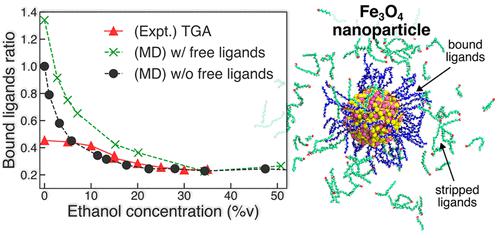Our official English website, www.x-mol.net, welcomes your feedback! (Note: you will need to create a separate account there.)
Solvent Effects in Ligand Stripping Behavior of Colloidal Nanoparticles
ACS Nano ( IF 15.8 ) Pub Date : 2023-06-13 , DOI: 10.1021/acsnano.3c01313 Akhlak U Mahmood 1 , Mehedi H Rizvi 1 , Joseph B Tracy 1 , Yaroslava G Yingling 1
ACS Nano ( IF 15.8 ) Pub Date : 2023-06-13 , DOI: 10.1021/acsnano.3c01313 Akhlak U Mahmood 1 , Mehedi H Rizvi 1 , Joseph B Tracy 1 , Yaroslava G Yingling 1
Affiliation

|
Inorganic colloidal nanoparticle (NP) properties can be tuned by stripping stabilizing ligands using a poor solvent. However, the mechanism behind ligand stripping is poorly understood, in part because in situ measurements of ligand stripping are challenging at the nanoscale. Here, we investigate ethanol solvent-mediated oleylamine ligand stripping from magnetite (Fe3O4) NPs in different compositions of ethanol/hexane mixtures using atomistic molecular dynamics (MD) simulations and thermogravimetric analysis (TGA). Our study elucidates a complex interplay of ethanol interactions with system components and indicates the existence of a threshold concentration of ∼34 vol % ethanol, above which ligand stripping saturates. Moreover, hydrogen bonding between ethanol and stripped ligands inhibits subsequent readsorption of the ligands on the NP surface. A proposed modification of the Langmuir isotherm explains the role of the enthalpy of mixing of the ligands and solvents on the ligand stripping mechanism. A good agreement between the MD predictions and TGA measurements of ligand stripping from Fe3O4 NPs validates the simulation observations. Our findings demonstrate that the ligand coverage of NPs can be controlled by using a poor solvent below the threshold concentration and highlight the importance of ligand–solvent interactions that modulate the properties of colloidal NPs. The study also provides an approach for a detailed in silico study of ligand stripping and exchange from colloidal NPs that are crucial for applications of NPs spanning self-assembly, optoelectronics, nanomedicine, and catalysis.
中文翻译:

溶剂对胶体纳米颗粒配体剥离行为的影响
无机胶体纳米粒子(NP)的性质可以通过使用不良溶剂剥离稳定配体来调节。然而,人们对配体剥离背后的机制知之甚少,部分原因是配体剥离的原位测量在纳米尺度上具有挑战性。在这里,我们使用原子分子动力学(MD)模拟和热重分析(TGA)研究了乙醇溶剂介导的油胺配体从不同组成的乙醇/己烷混合物中的磁铁矿(Fe 3 O 4 )纳米粒子的剥离。我们的研究阐明了乙醇与系统组分相互作用的复杂相互作用,并表明存在~34 vol%乙醇的阈值浓度,高于该浓度配体剥离饱和。此外,乙醇和剥离的配体之间的氢键抑制了配体随后在纳米粒子表面上的再吸附。朗缪尔等温线的拟议修改解释了配体和溶剂混合的焓对配体剥离机制的作用。从 Fe 3 O 4 NP剥离配体的 MD 预测和 TGA 测量之间的良好一致性验证了模拟观察结果。我们的研究结果表明,可以通过使用低于阈值浓度的不良溶剂来控制纳米颗粒的配体覆盖度,并强调了配体-溶剂相互作用对调节胶体纳米颗粒特性的重要性。该研究还提供了一种对胶体纳米粒子的配体剥离和交换进行详细计算机研究的方法,这对于纳米粒子在自组装、光电子学、纳米医学和催化方面的应用至关重要。
更新日期:2023-06-13
中文翻译:

溶剂对胶体纳米颗粒配体剥离行为的影响
无机胶体纳米粒子(NP)的性质可以通过使用不良溶剂剥离稳定配体来调节。然而,人们对配体剥离背后的机制知之甚少,部分原因是配体剥离的原位测量在纳米尺度上具有挑战性。在这里,我们使用原子分子动力学(MD)模拟和热重分析(TGA)研究了乙醇溶剂介导的油胺配体从不同组成的乙醇/己烷混合物中的磁铁矿(Fe 3 O 4 )纳米粒子的剥离。我们的研究阐明了乙醇与系统组分相互作用的复杂相互作用,并表明存在~34 vol%乙醇的阈值浓度,高于该浓度配体剥离饱和。此外,乙醇和剥离的配体之间的氢键抑制了配体随后在纳米粒子表面上的再吸附。朗缪尔等温线的拟议修改解释了配体和溶剂混合的焓对配体剥离机制的作用。从 Fe 3 O 4 NP剥离配体的 MD 预测和 TGA 测量之间的良好一致性验证了模拟观察结果。我们的研究结果表明,可以通过使用低于阈值浓度的不良溶剂来控制纳米颗粒的配体覆盖度,并强调了配体-溶剂相互作用对调节胶体纳米颗粒特性的重要性。该研究还提供了一种对胶体纳米粒子的配体剥离和交换进行详细计算机研究的方法,这对于纳米粒子在自组装、光电子学、纳米医学和催化方面的应用至关重要。







































 京公网安备 11010802027423号
京公网安备 11010802027423号